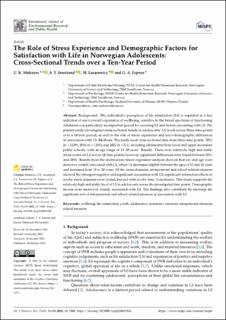| dc.contributor.author | Moksnes, Unni Karin | |
| dc.contributor.author | Innstrand, Siw Tone | |
| dc.contributor.author | Lazarewicz, Magdalena Anna | |
| dc.contributor.author | Espnes, Geir Arild | |
| dc.date.accessioned | 2023-05-19T07:22:48Z | |
| dc.date.available | 2023-05-19T07:22:48Z | |
| dc.date.created | 2023-01-20T10:55:49Z | |
| dc.date.issued | 2023 | |
| dc.identifier.citation | International Journal of Environmental Research and Public Health. 2023, 20 (3), 1940-?. | en_US |
| dc.identifier.issn | 1661-7827 | |
| dc.identifier.uri | https://hdl.handle.net/11250/3068277 | |
| dc.description.abstract | Background: The individual’s perception of life satisfaction (LS) is regarded as a key indicator of one’s overall experience of wellbeing, sensitive to the broad spectrum of functioning. Adolescence is particularly an important period for assessing LS and factors associating with LS. The present study investigated cross-sectional trends in adolescents’ LS levels across three time points over a 10-year period, as well as the role of stress experience and socio-demographic differences in association with LS. Methods: The study used cross-sectional data from three time points: 2011 (n = 1239), 2016 (n = 1233), and 2022 (n =311), including adolescents from lower and upper secondary public schools, with an age range of 13–20 years. Results: There were relatively high and stable mean scores on LS across all time points; however, significant differences were found between 2011 and 2016. Results from the multivariate linear regression analysis showed that sex and age were moreover weakly associated with LS, where LS decreased slightly between the ages of 13 and 18 years and increased from 19 to 20 years. Of the stress domains, interpersonal and school-related stressors showed the strongest negative and significant association with LS; significant interaction effects of sex by stress domains were found, but not with sex by time. Conclusion: This study supports the relatively high and stable level of LS in adolescents across the investigated time points. Demographic factors were moreover weakly associated with LS. The findings also contribute by showing the significant role of interpersonal and school-related stressors in association with LS. | en_US |
| dc.language.iso | eng | en_US |
| dc.publisher | MDPI | en_US |
| dc.rights | Navngivelse 4.0 Internasjonal | * |
| dc.rights.uri | http://creativecommons.org/licenses/by/4.0/deed.no | * |
| dc.title | The Role of Stress Experience and Demographic Factors for Satisfaction with Life in Norwegian Adolescents: Cross-Sectional Trends over a Ten-Year Period | en_US |
| dc.title.alternative | The Role of Stress Experience and Demographic Factors for Satisfaction with Life in Norwegian Adolescents: Cross-Sectional Trends over a Ten-Year Period | en_US |
| dc.type | Peer reviewed | en_US |
| dc.type | Journal article | en_US |
| dc.description.version | publishedVersion | en_US |
| dc.source.pagenumber | 1940-? | en_US |
| dc.source.volume | 20 | en_US |
| dc.source.journal | International Journal of Environmental Research and Public Health | en_US |
| dc.source.issue | 3 | en_US |
| dc.identifier.doi | 10.3390/ijerph20031940 | |
| dc.identifier.cristin | 2111329 | |
| cristin.ispublished | true | |
| cristin.fulltext | original | |
| cristin.qualitycode | 1 | |

